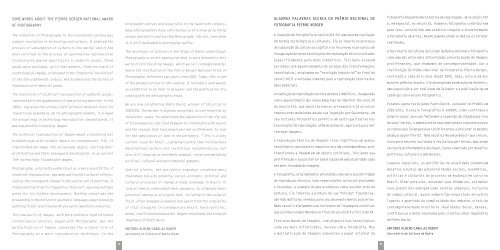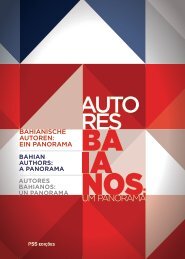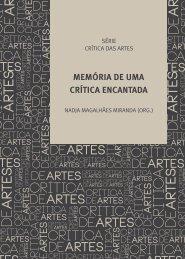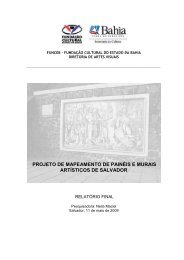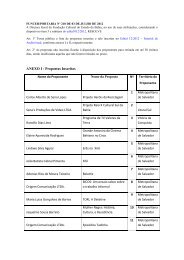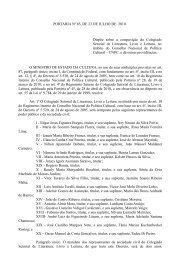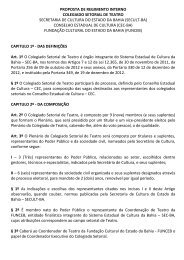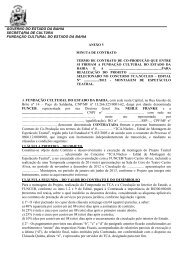Fazer download PDF - Fundação Cultural do Estado da Bahia
Fazer download PDF - Fundação Cultural do Estado da Bahia
Fazer download PDF - Fundação Cultural do Estado da Bahia
You also want an ePaper? Increase the reach of your titles
YUMPU automatically turns print PDFs into web optimized ePapers that Google loves.
Some words about the Pierre Verger National Award<br />
of Photography<br />
The invention of Photography in the nineteenth century was<br />
a major revolution in technology and culture. It entered the<br />
process of subsumption of culture to the capital and it had<br />
been enrolled in the process of opening new reproductive<br />
technologies geared specifically to symbolic goods. These<br />
goods were excluded, up to that moment, from the reach of<br />
technological change, originated in the “industrial revolution”<br />
of the late eighteenth century, which aimed only the technical<br />
reproduction of material goods.<br />
The revolution of technical reproduction of symbolic goods,<br />
launched with the appearance of new printing machines in the<br />
1830s, replaced the archaic craft printers modeled since its<br />
invention by Gutenberg. On its photographic moment, it allowed<br />
for a huge leap in technology reproduction: beyond words, it<br />
was now possible to portray images.<br />
The technical reproduction of images meant a technological<br />
breakthrough with notable impact on contemporary life. It<br />
transformed the image into an every<strong>da</strong>y object, starting their<br />
proliferation and their subsequent banalization, in an current<br />
life increasingly flooded with images.<br />
Photography, originally understood as a mere possibility of<br />
technical reproduction, had deep and fruitful cultural effects,<br />
such as the consequent change in the secular art of painting. It<br />
freed painting from its figurative “mission”, opening multiple<br />
paths for its further development. Nothing casual was the<br />
broadening in the horizon of aesthetic languages experienced by<br />
painting in the late nineteenth and early twentieth centuries.<br />
This new world of images, with more and more sophisticated<br />
technological devices, began with Photography. But the<br />
nineteenth century and especially in the twentieth century,<br />
many photographers have contributed to this move by building<br />
unique aesthetics and turning Photography into Art, even when<br />
it is still dedicated to portraying reality.<br />
The Secretary of Culture of the State of <strong>Bahia</strong> understands<br />
Photography as an art expression that is most attuned to this<br />
world of proliferating images, which we call contemporaneity.<br />
Hence the institution of the Pierre Verger National Prize of<br />
Photography, held every two years since 2002. To<strong>da</strong>y, this is one<br />
of the greatest prizes in the country. It includes a cash award,<br />
an exhibition to be held in Salva<strong>do</strong>r and the publication of a<br />
catalog with the photographic essay.<br />
We are now celebrating Pedro David, winner of the prize in<br />
2010/2011. The Garden is an photo essay that, as confirmed the by<br />
the author, seeks “to understand the expansion of the city out<br />
of its boun<strong>da</strong>ries; the clash between its inhabitants with nature<br />
and the reasons that lead people who are so different, to look<br />
for the same pieces of land in the periphery. “ This is a very<br />
current issue for Brazil, a growing country that incorporates<br />
marginalized sectors and revitalizes neighborhoods, but<br />
also still shows up as extremely unequal, tense and marked by<br />
political, cultural and environmental demands.<br />
Special places, the periphery nowa<strong>da</strong>ys condense many<br />
challenges but also potential social, economic, political and<br />
cultural processes of change already underway in Brazil. To<br />
look at them to understand their dynamics, to stimulate their<br />
potential emerge as an urgent task, including in the cultural<br />
field, often engaged elsewhere and apart from the complexity<br />
of vital struggles in contemporary Brazil. Hard realities,<br />
dense, conflicted and beautiful images revealed by the creative<br />
imaginary of Pedro David.<br />
Algumas palavras acerca <strong>do</strong> Prêmio Nacional de<br />
Fotografia Pierre Verger<br />
A invenção <strong>da</strong> fotografia no século XIX foi uma enorme revolução<br />
em termos tecnológicos e culturais. Ela se inseriu no processo<br />
de subsunção <strong>da</strong> cultura ao capital e se inscreveu no processo de<br />
inauguração de novas tecnologias de reprodução técnica volta<strong>da</strong>s<br />
especificamente para bens simbólicos. Tais bens estavam<br />
excluí<strong>do</strong>s até aquele momento <strong>do</strong> alcance <strong>da</strong>s transformações<br />
tecnológicas, origina<strong>da</strong>s na “revolução industrial” <strong>do</strong> final <strong>do</strong><br />
século XVIII e volta<strong>da</strong>s somente para a reprodução técnica <strong>do</strong>s<br />
bens materiais.<br />
A revolução <strong>da</strong> reprodução técnica de bens simbólicos, inaugura<strong>da</strong><br />
com o aparecimento <strong>da</strong>s novas máquinas de imprimir <strong>do</strong>s anos 30<br />
<strong>do</strong> século XIX, que substituíram as artesanais e já arcaicas<br />
impressoras modela<strong>da</strong>s desde sua invenção por Gutenberg, em<br />
seu instante fotográfico permitiu um salto qualitativo nas<br />
tecnologias de reprodução: além de palavras, agora era possível<br />
retratar imagens.<br />
A reprodução técnica de imagens fixas significou um avanço<br />
tecnológico com notáveis impactos na vi<strong>da</strong> contemporânea, pois<br />
transformou a imagem em um objeto cotidiano, inician<strong>do</strong> sua<br />
proliferação e sua posterior banalização em uma atuali<strong>da</strong>de ca<strong>da</strong><br />
vez mais inun<strong>da</strong><strong>da</strong> de imagens.<br />
A fotografia, originalmente entendi<strong>da</strong> como mera possibili<strong>da</strong>de<br />
de reprodução técnica, teve repercussões culturais profun<strong>da</strong>s<br />
e fecun<strong>da</strong>s, a exemplo <strong>do</strong> que aconteceu com a secular arte <strong>da</strong><br />
pintura. Ela libertou a pintura de sua “missão” figurativa,<br />
abrin<strong>do</strong> múltiplas vere<strong>da</strong>s para seu desenvolvimento posterior.<br />
Na<strong>da</strong> casual o alargamento <strong>do</strong> horizonte de linguagens estéticas<br />
que a pintura experimentou no final <strong>do</strong> século XIX e início <strong>do</strong> XX.<br />
Este novo mun<strong>do</strong> de imagens, com dispositivos tecnológicos<br />
fotografia enquanto mera técnica de reprodução. Já no século XIX<br />
e, em especial, no século XX, inúmeros fotógrafos contribuíram<br />
para isso, construin<strong>do</strong> uma estética singular e transforman<strong>do</strong><br />
a fotografia em artes, mesmo quan<strong>do</strong> ain<strong>da</strong> se dedica a retratar<br />
reali<strong>da</strong>des.<br />
A Secretaria de Cultura <strong>do</strong> Esta<strong>do</strong> <strong>da</strong> <strong>Bahia</strong> entende a fotografia<br />
como uma <strong>da</strong>s artes mais sintoniza<strong>da</strong>s com este mun<strong>do</strong> de imagens<br />
proliferantes, que chamamos de contemporanei<strong>da</strong>de. Daí a<br />
instituição <strong>do</strong> Prêmio Nacional de Fotografia Pierre Verger,<br />
realiza<strong>do</strong> a ca<strong>da</strong> <strong>do</strong>is anos desde 2002. Hoje, este é um <strong>do</strong>s<br />
maiores prêmios <strong>do</strong> país. Ele abrange uma premiação em dinheiro,<br />
uma exposição a ser realiza<strong>da</strong> em Salva<strong>do</strong>r e a publicação de um<br />
catálogo com o ensaio fotográfico.<br />
Estamos agora festejan<strong>do</strong> Pedro David, vence<strong>do</strong>r <strong>do</strong> Prêmio em<br />
2010/2011. O ensaio fotográfico O Jardim, como confirmou o<br />
próprio autor, procura “entender a expansão <strong>da</strong> ci<strong>da</strong>de para fora<br />
de seus limites, o embate entre seus habitantes com a natureza e<br />
as razoes que levam pessoas tão diferentes a procurar os mesmos<br />
pe<strong>da</strong>ços <strong>da</strong> periferia”. Tema atualíssimo em um Brasil que cresce,<br />
incorpora setores excluí<strong>do</strong>s e revitaliza periferias, mas ain<strong>da</strong><br />
se revela profun<strong>da</strong>mente desigual, tenso e marca<strong>do</strong> por desafios<br />
políticos, culturais e ambientais.<br />
Lugares especiais, as periferias na atuali<strong>da</strong>de condensam<br />
desafios e muitas <strong>da</strong>s potenciali<strong>da</strong>des sociais, econômicas,<br />
políticas e culturais <strong>do</strong> processo de mu<strong>da</strong>nça em curso no<br />
Brasil. Olhar para elas, entender suas dinâmicas, estimular<br />
seus potenciais emergem como tarefas urgentes, inclusive<br />
<strong>do</strong> campo cultural, quase sempre tão enquista<strong>do</strong> em outros<br />
lugares e aparta<strong>do</strong> <strong>da</strong> complexi<strong>da</strong>de <strong>do</strong>s embates vitais <strong>da</strong><br />
contemporanei<strong>da</strong>de brasileira. Reali<strong>da</strong>des duras, densas,<br />
conflituosas e belas revela<strong>da</strong>s pelo criativo olhar imaginário<br />
de Pedro David.<br />
multiplication of images subverted the original role of<br />
Photography as a mere reproduction technique. In the<br />
Antonio Albino Canelas Rubim<br />
Secretary of Culture of <strong>Bahia</strong> State<br />
ca<strong>da</strong> vez mais sofistica<strong>do</strong>s, nasceu com a fotografia. Mas<br />
a multiplicação de imagens subverteu o papel original <strong>da</strong><br />
Antonio Albino Canelas Rubim<br />
Secretário de Cultura <strong>da</strong> <strong>Bahia</strong><br />
4 5


